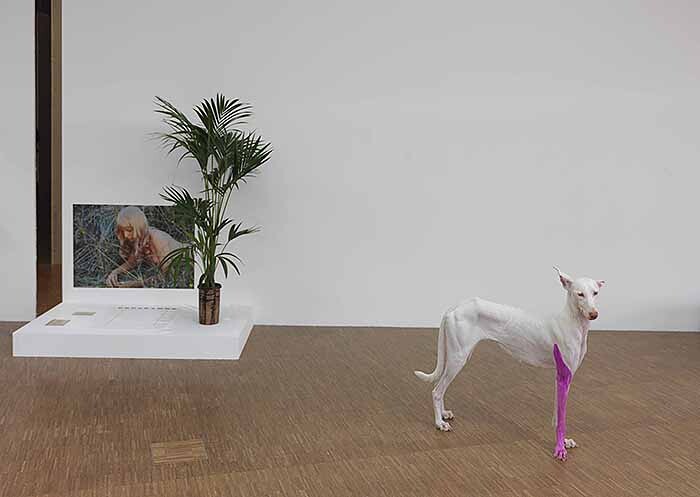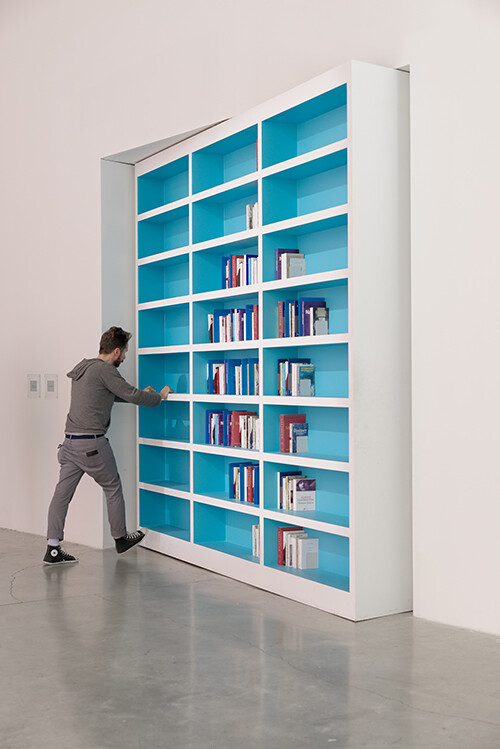I hate to admit this now, but my eyes rolled involuntarily when I first heard that the Centre Pompidou and the Palais de Tokyo would be holding solo exhibitions of work by Pierre Huyghe and Philippe Parreno, since both artists have already had major shows in Paris museums, but it turns out to be longer ago than I thought (2006 for Huyghe and 2009 for Parreno). At the same time, I also harbored the fantasy that the Musée d’Art Moderne de la Ville de Paris would suddenly wager on a historic trifecta and simultaneously unveil a Dominique Gonzalez-Foerster exhibition, thus providing comparative mid-career overviews of these three established artistic associates, all of whom are at the top of their aesthetic game. As it stands, Huyghe and Parreno’s respective exhibitions generously acknowledge and include a whole host of friends (Gonzalez-Foerster among them), influences, iconic figures, and collaborators, as well as myriad living creatures, in Huyghe’s case, and an abundance of phantoms, in Parreno’s.
If the art world, and the French art world in particular, has a reputation for being intimidatingly cliquish or clannish, a remarkable and surely unintentional achievement of these exhibitions is that they testify to the singular importance of artistic friendships and creative alliances, best exemplified by the charming, hidden display of drawings by composer John Cage and choreographer and dancer Merce Cunningham nestled behind Gonzalez-Foerster’s La Bibliothèque clandestine [Secret Library] (2013) in Parreno’s “Anywhere, Anywhere Out of the World.” Entitled A Reenactment: Margarete Roeder Gallery (2002–13), this work evolves according to chance as exhibition staff replaces one of Cage’s spare drawings based on the Zen garden at the Ryōan-ji Temple in Kyoto with more colorful and exuberant drawings of birds by Cunningham. But one could also cite Huyghe and Parreno’s collaboration on No Ghost Just a Shell (1999–2003), in which a formerly abandoned, then purchased female manga character, Ann Lee, is animated by a collective of artists including Rirkrit Tiravanija, Melik Ohanian, and Tino Sehgal—versions of which feature in both exhibitions—or Douglas Gordon and Parreno’s Zidane: A 21st Century Portrait (2006), which is shown in a sumptuous, seventeen-screen installation in the cavernous lower level of the Palais de Tokyo.
Shuttling between the two venues, one sees the extent to which Huyghe and Parreno’s artistic trajectories depart from shared associations, then intersect and diverge across a vast territory of common interests—cinema, architecture, travel, literature, education, public space, and cultural memory—which they mine, as did Cage and Cunningham, in extraordinarily singular ways. I don’t want to over-romanticize or idealize this history; I have no personal insight into their private lives and no stake in maintaining that the 1990s were a heyday for French contemporary art. However, I do think the context within which contemporary artistic identities are shaped and formed can and should be acknowledged—and our viewpoints adjusted, when possible—in order to allow us to look outside the received frames of critical theorization and historicization (such as the “Relational Aesthetics” label that has stuck to readings of both artists’ work). The French have a saying “remettre les pendules à l’heure,” which translates as “to set the record straight,” but which literally means “to set the (pendulum) clock right.” Given both artists’ fascination with time, that phrase kept popping into my mind. Both exhibitions amply demonstrate that the artists’ individual works and their oeuvres as a whole are replete with temporal complexities, which they spatialize in radically different ways that durably impact our perception and experiences.
The exhibition floor plans are instructive in this regard: Huyghe composed his show around the walls still in place from the previous exhibition, a Mike Kelley retrospective, and the idea of a garden serves as an explicit template for the juxtaposition of some fifty works dating from the 1980s to the present, including my unimpeachable favorite of his films Streamside Day Follies (2003), the musical-game installation Atari Light (1999), and the L’Expédition Scintillante, Act III, Untitled (Black Ice Stage) (2002), from his multi-form L’Expédition Scintillante [Scintillating Expedition] project. Huyghe gestures toward origins from the outset by placing little-known Parvine Curie’s squat, rough-hewn, and degraded abstract stone sculpture Mère Anatolica 1 (1975) center stage at the entrance to his exhibition, accompanied by Sound Extract From a Day of the Institut des Hautes Études en Arts Plastiques [Institute of Advanced Studies in the Visual Arts] (1988), an archival recording from the experimental, interdisciplinary art institute founded and run by the late museum director and collector Pontus Hultén and artist Daniel Buren between 1988 and 1995. Mère Anatolica 1, in fact, was commissioned by the popular “1% for art” scheme in France and stood outside Huyghe’s junior high school.
Taken together, these fragments offer an initial glimpse into the artist’s biography and French cultural history, which are not treated in a linear fashion, but rather according to the principle of his work Timekeeper (1999–2013)—a hole dug into the walls of his various exhibition spaces, which reveals successive layers of paint, much like the rings of a tree’s trunk indicate its age. With Huyghe, timing can be everything. On my first visit, the fuchsia-legged greyhound named “Human,” who scampered around the artist’s garden installation Untilled (Liegender Frauenakt) [Untilled (Reclining Female Nude)] (2012) at Documenta 13, circulated behind his LED-masked trainer, a bird-headed person sat on a bench, and a skater took to the ice to repeat her rhythmic loops. On a subsequent visit, I saw none of these things.
By contrast, Parreno took possession of the exterior of his venue by hanging a huge, crystalline cinema Marquee (2013) above the entrance door to the Palais de Tokyo. Inside he transformed the welcome desk into a luminous wall—Untitled (2013), a work which prompted another eye-rolling moment, this time with no regret given the rudeness of the hostess, which at least coheres with the generally inhospitable nature of the Palais de Tokyo renovation. He occupied all levels of the 22,000-square-meter space with works specially conceived for it (a new installation of sixteen other marquees, Danny The Street (2013), illuminates one pitch-black room downstairs), as well as others that date primarily from the past decade.
Parreno often favors choreographing the viewer via script and score and here that score is Igor Stravinsky’s Petrushka, composed for the Paris-based Ballets Russes in 1910–11, and automatically played on Disklaviers placed strategically about the space. The piano music regulates the viewer’s time as flickering lamps and labels (56 Flickering Lights and Flickering Labels, both 2013), coordinated to the sound, lead her as if in a fairy-tale, toward the shadowy depths of the building. Petrushka was a doll who was magically brought to life then slain and transformed into a ghost, and the figure of the automaton (or artist as puppeteer, I’m not quite sure which) looms extra large on a mammoth LED screen on the ground floor gallery in the video The Writer (2007), which depicts an eighteenth-century automaton by Swiss watchmaker Pierre Jaquet-Droz writing out the question, “What do you believe, your eyes or my words?” by hand. Robotic inscription also factors in Marilyn (2012), a ghost-portrait of Marilyn Monroe that relies on mechanically operated cameras and the Hollywood star’s computerized voice to piece together a narrative, as well as in Autograph (2013), in which a machine initially programmed to write like Monroe can now reproduce the artist’s own handwriting instead.
Huyghe and Parreno have always confessed their strong interest in the exhibition as a format, parameter, and medium—as a moment in which work seems frozen in time for a viewer, but nevertheless remains in flux for the artist. Huyghe sees the boundaries between things presented and the representation the exhibition offers as porous and malleable, which is reflected in his placement of the works and the blending of sounds. He has stated he “wants to exhibit someone to something,” rather than the inverse, while Parreno sees the exhibition as “an act of creation.” In both cases, one is tempted instantly to ditch the map and simply wander.











